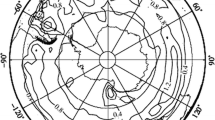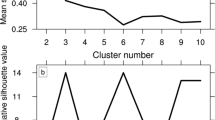Abstract
A probabilistic clustering method is used to describe various aspects of tropical cyclone (TC) tracks in the Southern Hemisphere, for the period 1969–2008. A total of 7 clusters are examined: three in the South Indian Ocean, three in the Australian Region, and one in the South Pacific Ocean. Large-scale environmental variables related to TC genesis in each cluster are explored, including sea surface temperature, low-level relative vorticity, deep-layer vertical wind shear, outgoing longwave radiation, El Niño-Southern Oscillation (ENSO) and the Madden-Julian Oscillation (MJO). Composite maps, constructed 2 days prior to genesis, show some of these to be significant precursors to TC formation—most prominently, westerly wind anomalies equatorward of the main development regions. Clusters are also evaluated with respect to their genesis location, seasonality, mean peak intensity, track duration, landfall location, and intensity at landfall. ENSO is found to play a significant role in modulating annual frequency and mean genesis location in three of the seven clusters (two in the South Indian Ocean and one in the Pacific). The ENSO-modulating effect on genesis frequency is caused primarily by changes in low-level zonal flow between the equator and 10°S, and associated relative vorticity changes in the main development regions. ENSO also has a significant effect on mean genesis location in three clusters, with TCs forming further equatorward (poleward) during El Niño (La Niña) in addition to large shifts in mean longitude. The MJO has a strong influence on TC genesis in all clusters, though the amount modulation is found to be sensitive to the definition of the MJO.

















Similar content being viewed by others
References
Barnston AG, Chelliah M, Goldenberg SB (1997) Documentation of a highly ENSO-related SST region in the equatorial Pacific. Atmos-Ocean 35:367–383
Basher RE, Zheng X (1995) Tropical cyclones in the southwest Pacific: spatial patterns and relationships to Southern Oscillation and sea surface temperature. J Clim 8:1249–1260
Bell GD et al (2000) The 1999 North Atlantic hurricane season: a climate perspective. State of the Climate in 1999. Bull Am Meteorol Soc 81:S1–S50
Bender MA, Ginis I (2000) Simulations of hurricane-ocean interaction using a high-resolution coupled model: effects on hurricane intensity. Mon Weather Rev 128:917–946
Bessafi M, Wheeler MC (2006) Modulation of south Indian Ocean tropical cyclones by the Madden–Julian oscillation and convectively coupled equatorial waves. Mon Weather Rev 134:638–656
Bowman AW, Azzalini A (1997) Applied smoothing techniques for data analysis: the kernel approach with S-plus illustrations. Oxford University Press, Oxford
Broadbridge LW, Hanstrum BN (1998) The relationship between tropical cyclones near Western Australia and the southern Oscillation index. Aust Meteorol Mag 47:183–189
Callaghan J, Power SB (2011) Variability and decline in the number of severe tropical cyclones making land-fall over eastern Australia since the late nineteenth century. Clim Dyn. Online first, doi:10.1007/s00382-010-0883-2
Camargo SJ, Sobel AH (2005) Western North Pacific tropical cyclone intensity and ENSO. J Clim 18:2996–3006
Camargo SJ, Robertson AW, Gaffney SJ, Smyth P, Ghil M (2007a) Cluster analysis of typhoon tracks. Part I: general properties. J Clim 20:3635–3653
Camargo SJ, Robertson AW, Gaffney SJ, Smyth P, Ghil M (2007b) Cluster analysis of typhoon tracks. Part II: large-scale circulation and ENSO. J Clim 20:3654–3676
Camargo SJ, Emanuel K, Sobel AH (2007c) Use of a genesis potential index to diagnose ENSO effects on tropical cyclone genesis. J Clim 20:4819–4834
Camargo SJ, Robertson AW, Barnston AG, Ghil M (2008) Clustering of eastern North Pacific tropical cyclone tracks: ENSO and MJO effects. Geochem Geophys Geosyst 9:Q06V05. doi:10.1029/2007GC001861
Camargo SJ, Wheeler MC, Sobel AH (2009) Diagnosis of the MJO modulation of tropical cyclogenesis using an empirical index. J Atmos Sci 66:3061–3074
Camargo SJ, Sobel AH, Barnston AG, Klotzbach PJ (2010) The influence of natural climate variability on tropical cyclones and seasonal forecasts of tropical cyclone activity, Chapter 11. In: Chan JCL, Kepert JD (eds) Global perspectives on tropical cyclones, from science to mitigation, vol 4, 2nd edn. World Scientific Series on Earth System Science in Asia, Singapore, pp 325–360. ISBN 978-981-4293-47-1
Chand SS, Walsh KJE (2009) Tropical cyclone activity in the Fiji region: spatial patterns and relationship to large-scale circulation. J Clim 22:3877–3893
Chand SS, Walsh KJE (2010) The influence of the Madden–Julian oscillation on tropical cyclone activity in the Fiji region. J Clim 23:868–886
Dare RA, Davidson NE (2004) Characteristics of tropical cyclones in the Australian region. Mon Weather Rev 132:3049–3065
Elsner JB (2003) Tracking hurricanes. Bull Am Meteorol Soc 84:353–356
Elsner JB, Liu KB (2003) Examining the ENSO-typhoon hypothesis. Clim Res 25:43–54
Evans JL, Allan RJ (1992) El Niño/Southern Oscillation modification to the structure of the monsoon and tropical cyclone activity in the Australasian region. Int J Climatol 12:611–623
Gaffney SJ (2004) Probabilistic curve-aligned clustering and prediction with regression mixture models. Ph.D. thesis, University of California, Irvine, 281 pp. Available online at http://www.ics.uci.edu/pub/sgaffney/outgoing/sgaffney_thesis.pdf
Gaffney SJ, Robertson AW, Smyth P, Camargo SJ, Ghil M (2007) Probabilistic clustering of extratropical cyclones using regression mixture models. Clim Dyn 29:423–440
Goddard L, Dilley M (2005) El Niño: catastrophe or opportunity? J Clim 18:651–655
Goebbert KH, Leslie LM (2010) Interannual variability of northwestern Australian tropical cyclones. J Clim 23:4538–4555
Gray WM (1968) Global view of the origin of tropical disturbances and storms. Mon Weather Rev 96:669–700
Hall JD, Matthews AJ, Karoly DJ (2001) The modulation of tropical cyclone activity in the Australian region by the Madden–Julian oscillation. Mon Weather Rev 129:2970–2982
Harper BA, Stroud SA, McCormack M, West S (2008) A review of historical tropical cyclone intensity in northwestern Australia and implications for climate change trend analysis. Aust Meteorol Mag 57:121–141
Harr PA, Elsberry RL (1995) Large-scale circulation variability over the tropical western North Pacific. Part I: spatial patterns and tropical cyclone characteristics. Mon Weather Rev 123:1225–1246
Hassim MEE, Walsh KJE (2008) Tropical cyclone trends in the Australian region. Geochem Geophys Geosys 9:Q07V07
Hastings PA (1990) Southern Oscillation influences on tropical cyclone activity in the Australian South-West Pacific region. Int J Climatol 10:291–298
Hintze JL, Nelson RD (1998) Violin plots: a box plot-density trace synergism. Am Stat 52:181–184
Ho C-H, Kim J-H, Jeong J-H, Kim H-S, Chen D (2006) Variation of tropical cyclone activity in the South Indian Ocean: El Niño–Southern Oscillation and Madden–Julian Oscillation effects. J Geophys Res 111:D22101. doi:10.1029/2006JD007289
Holland GJ (1984) Tropical cyclone motion: a comparison of theory and observation. J Atmos Sci 41:68–75
Kalnay E et al (1996) The NCEP/NCAR 40-year reanalysis project. Bull Am Meteorol Soc 77:437–471
Kim H-S, Kim J-H, Ho C-H, Chu P-S (2011) Pattern classification of typhoon tracks using the fuzzy c-means clustering method. J Clim 24:448–508
Knapp KR, Kruk MC, Levinson DH, Diamond HJ, Neumann CJ (2010) The international best track archive for climate stewardship (IBTrACS): unifying tropical cyclone data. Bull Am Meteorol Soc 91:363–376
Kossin JP, Camargo SJ (2009) Hurricane track variability and secular potential intensity trends. Clim Change 9:329–337
Kossin JP, Knapp KR, Vimont DJ, Murnane RJ, Harper BA (2007) A globally consistent reanalysis of hurricane variability and trends. Geophys Res Lett 34:L04815
Kossin JP, Camargo SJ, Sitkowski M (2010) Climate modulation of North Atlantic hurricane tracks. J Clim 23:3057–3076
Kuleshov Y, de Hoedt G (2003) Tropical cyclone activity in the Southern Hemisphere. Bull Aust Meteorol Oceanogr Soc 16:135–137
Kuleshov Y, Qi L, Fawcett R, Jones D (2008) On tropical cyclone activity in the Southern Hemisphere: trends and the ENSO connection. Geophys Res Lett 35:L14S08. doi:10.1029/2007GL032983
Kuleshov Y, Ming FC, Qi L, Choaibou I, Hoareau C, Roux F (2009) Tropical cyclone genesis in the southern hemisphere and its relationship with ENSO. Ann Geophys 27:2423–2538
Kuleshov Y, Fawcett R, Qi L, Trewin B, Jones D, McBride J, Ramsay H (2010) Trends in tropical cyclones in the South Indian Ocean and the South Pacific Ocean. J Geophys Res 115:D01101. doi:10.1029/2009JD012372
Künsch HR (1989) The jackknife and the bootstrap for general stationary observations. Ann Stat 17:1217–1241
Leroy A, Wheeler MC (2008) Statistical prediction of weekly tropical cyclone activity in the southern Hemisphere. Mon Weather Rev 136:1083–1103
Liebmann B, Smith CA (1996) Description of a complete (interpolated) outgoing longwave radiation dataset. Bull Am Meteorol Soc 77:1275–1277
Liebmann B, Hendon HH, Glick JD (1994) The relationship between tropical cyclones of the western Pacific and Indian oceans and the Madden-Julian oscillation. J Meteorol Soc Jpn 72:401–412
Liu RY, Singh K (1992) Moving blocks bootstrap captures weak dependence. In: Lepage R, Billard L (eds) Exploring the limits of bootstrap. Wiley, New York, pp 225–248
McBride JL, Keenan TD (1982) Climatology of tropical cyclone genesis in the Australian region. J Climatol 2:13–33
Meehl GA (1987) The annual cycle and interannual variability in the tropical Indian and Pacific Ocean regions. Mon Weather Rev 115:27–50
Nakamura J, Lall U, Kushnir Y, Camargo SJ (2009) Classifying North Atlantic tropical cyclone tracks by their mass moments. J Clim 22:5481–5494
Neumann CJ (1993) Global overview. In: Holland G (ed) Global guide to tropical cyclone forecasting, vol 1. WMO, Geneva, pp 1–56
Nicholls N (1979) A possible method for predicting seasonal tropical cyclone activity in the Australian region. Mon Weather Rev 107:1221–1224
Nicholls N (1984) The southern oscillation, sea-surface temperature, and internannual fluctuations in Australian tropical cyclone activity. J Climatol 4:661–670
Nicholls N (1985) Predictability of interannual variations in Australian seasonal tropical cyclone activity. Mon Weather Rev 113:1144–1149
Nicholls N, Landsea CW, Gill J (1998) Recent trends in Australian tropical cyclone activity. Meteorol Atmos Phys 65:197–205
Pezza AB, Simmonds I (2008) Large-scale factors in tropical and extratropical cyclone transition and extreme weather events. Ann NY Acad Sci 1146:189–211. doi:10.1196/annals.1446.005
Philander SGH, Gu D, Halpern D, Lambert G, Lau N-C, Li T, Pacanowski RC (1996) Why the ITCZ is mostly north of the equator. J Clim 9:2958–2972
Ramsay HA, Leslie LM, Lamb PJ, Richman MB, Leplastrier M (2008) Interannual variability of tropical cyclones in the Australian region: role of large-scale environment. J Clim 21:1083–1103
Rasmusson EM, Carpenter TH (1982) Variations in tropical sea surface temperature and surface wind fields associated with the Southern Oscillation/El Niño. Mon Weather Rev 110:354–384
Revell CG, Goulter SW (1986) South Pacific tropical cyclones and the Southern Oscillation. Mon Weather Rev 114:1138–1145
Reynolds RW, Rayner NA, Smith TM, Stokes DC, Wang W (2002) An Improved In Situ and Satellite SST Analysis for Climate. J Clim 15:1609–1625
Ritchie EA, Holland GJ (1999) Large-scale patterns associated with tropical cyclogenesis in the western Pacific. Mon Weather Rev 127:2027–2043
Sinclair MR (2002) Extratropical transition of Southwest Pacific tropical cyclones. Part I: climatology and mean structure changes. Mon Weather Rev 130:590–609
Solow A, Nichols N (1990) The relationship between the Southern Oscillation and tropical cyclone frequency in the Australian region. J Clim 3:1097–1101
Vanderviere E, Huber M (2004) An adjusted boxplot for skewed distributions. In: Antoch J (ed) COMPSTAT 2004, proceedings in computational statistics. Springer, Heidelberg, pp 1933–1940
Vincent EM et al (2009) Interannual variability of the South Pacific Convergence Zone and implications for tropical cyclone genesis. Clim Dyn. doi:10.1007/s0038200907163
Waliser DE, Gautier C (1993) A satellite-derived climatology of the ITCZ. J Clim 6:2162–2174
Wheeler M, Hendon HH (2004) An all-season real-time multivariate MJO index: development of an index for monitoring and prediction. Mon Weather Rev 132:1917–1932
Wheeler M, Kiladis GN (1999) Convectively coupled equatorial waves: analysis of clouds and temperature in the wavenumber–frequency domain. J Atmos Sci 56:374–399
Acknowledgments
We are grateful to Matthew Wheeler for helpful discussions concerning the MJO. HAR acknowledges support by an appointment to the NASA Postdoctoral Program at the Goddard Institute for Space Studies, administered by Oak Ridge Associated Universities through a contract with NASA. SJC acknowledges support from NOAA Grant NA08OAR44320912. DK was supported by NASA Grant NNX09AK34G.
Author information
Authors and Affiliations
Corresponding author
Rights and permissions
About this article
Cite this article
Ramsay, H.A., Camargo, S.J. & Kim, D. Cluster analysis of tropical cyclone tracks in the Southern Hemisphere. Clim Dyn 39, 897–917 (2012). https://doi.org/10.1007/s00382-011-1225-8
Received:
Accepted:
Published:
Issue Date:
DOI: https://doi.org/10.1007/s00382-011-1225-8




